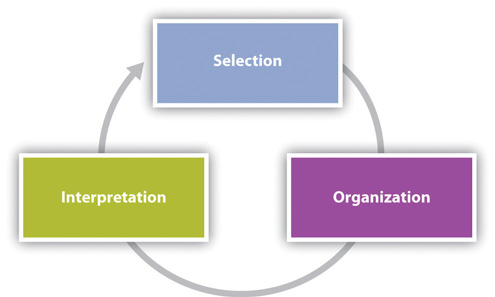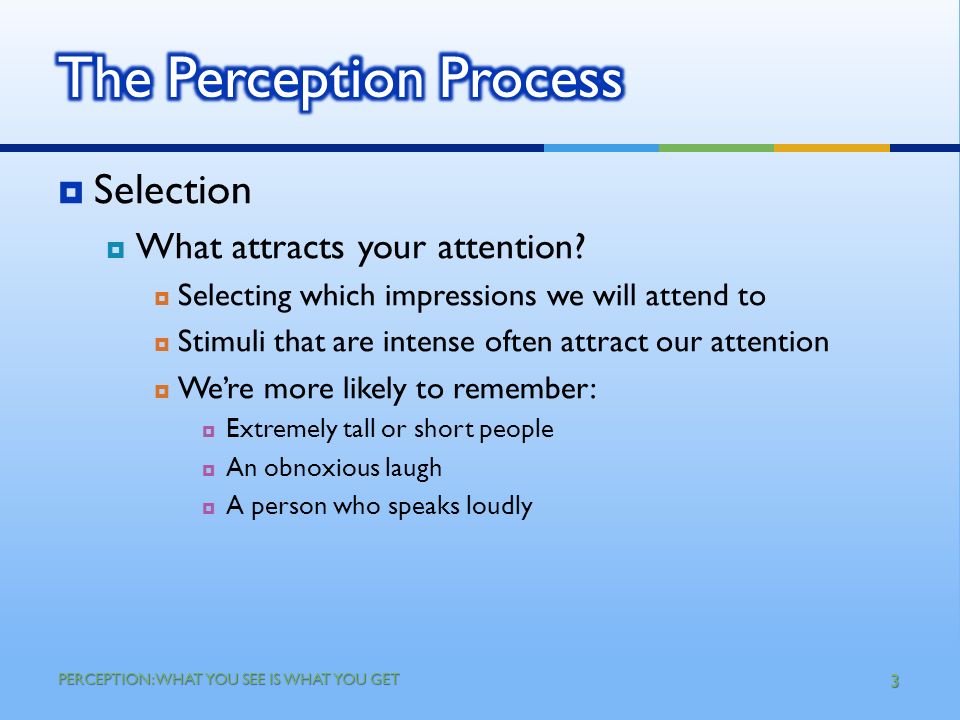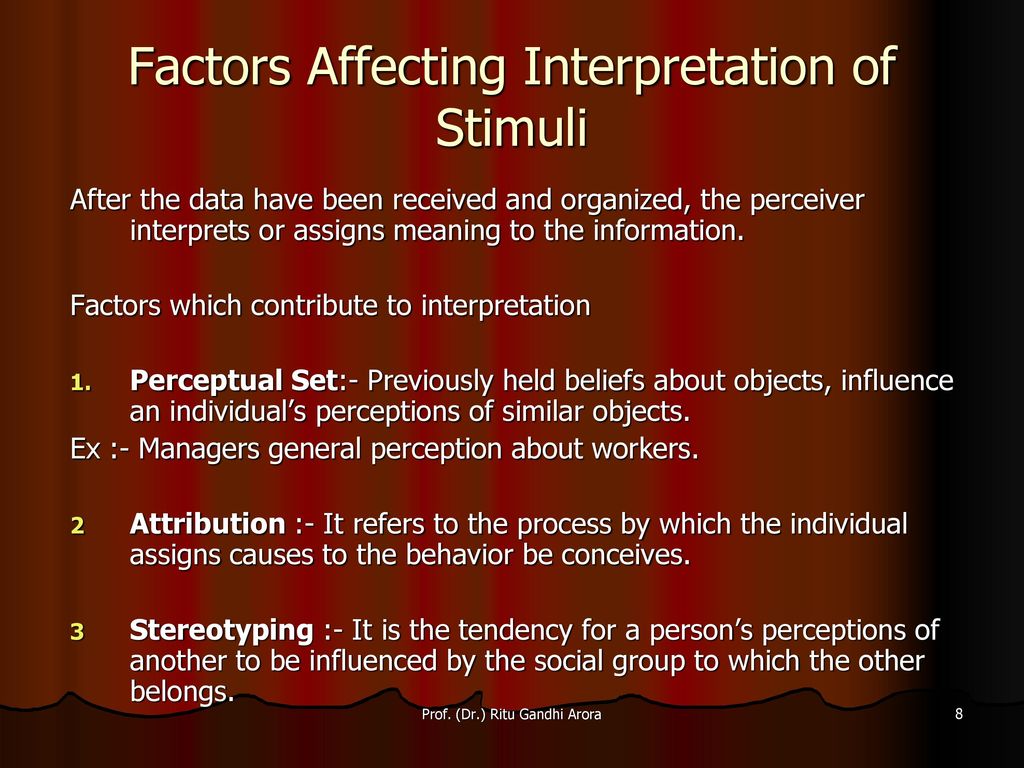2.2: Role of Perception in Communication
- Page ID
- 135737
A neighbor who is usually friendly has not responded to your “Good morning” message for three days in a row. How would you perceive being ignored?
Instead of deciding to never speak to that person again, check your perception to see if there is something wrong with the neighbor. Give the neighbor the benefit of the doubt; share your perception of his or her behavior, and ask if everything is all right.
Conducting a perception check will help you avoid jumping to incorrect conclusions.
Perception and Communication
Perception is the way in which we see the world, and each of us sees the world differently. As a result, each of us comes to a conversation with different ways of talking and of doing things. Perception directly affects the way we communicate. More often than not, we perceive based on our frame of reference, which includes our background, attitudes, beliefs, experiences, and culture. These aspects not only affect our intrapersonal communication, but also drive how we communicate daily with others. Perception colors the way we create and respond to messages.
Keep in mind that when you are talking with others, they have their own frame of reference driving their thought processes. No two people have exactly the same frame of reference!
Perception Process
Perception is the process of selecting, organizing, and interpreting information. This process, includes the perception of select stimuli that pass through our perceptual filters, are organized into our existing structures and patterns, and are then interpreted based on previous experiences. Although perception is a largely cognitive and psychological process, how we perceive the people and objects around us affects our communication. We respond differently to an object or person that we perceive favorably than we do to something we find unfavorable. But how do we filter through the mass amounts of incoming information, organize it, and make meaning from what makes it through our perceptual filters and into our social realities?

Selecting Information
We take in information through all five of our senses, but our perceptual field (the world around us) includes so many stimuli that it is impossible for our brains to process and make sense of it all. Selecting is the first part of the perception process, in which we focus our attention on certain incoming sensory information.
about how, out of many other possible stimuli to pay attention to, you may hear a familiar voice in the hallway, see a pair of shoes you want to buy from across the mall, or smell something cooking for dinner when you get home from work. We quickly cut through and push to the background all kinds of sights, smells, sounds, and other stimuli, but how do we decide what to select and what to leave out?

We select information based on:
Needs and Interests - We tend to pay attention to information that we perceive to meet our needs or interests in some way. We know what interests us and we automatically gravitate toward stimuli that match up with that.
Expectations - Since we expect something to happen, we may be extra tuned in to clues that it is coming.
Organizing Information
Organizing is the second part of the perception process, in which we sort and categorize information that we perceive. We organize interactions and interpersonal experiences based on our firsthand experiences
We also organize information based on:
Similarity - We tend to think similar-looking or similar-acting things belong together and we have a tendency to perceive others as similar to us
Difference - We assume that the item that looks or acts different from the rest doesn’t belong

Interpreting Information
Interpretation is the third part of the perception process, in which we assign meaning to our experiences using mental structures known as schemata. Schemata are like databases of stored, related information that we use to interpret new experiences. We all have fairly complicated schemata that have developed over time as small units of information combine to make more meaningful complexes of information.
It’s important to be aware of schemata because our interpretations affect our behavior. For example, if you are doing a group project for class and you perceive a group member to be shy based on your schema of how shy people communicate, you may avoid giving him presentation responsibilities in your group project because you do not think shy people make good public speakers. Schemata also guide our interactions, providing a script for our behaviors. We know, in general, how to act and communicate in a waiting room, in a classroom, on a first date, and on a game show. Even a person who has never been on a game show can develop a schema for how to act in that environment by watching Beat Shazam, for example.
Schemata are used to interpret others’ behavior and form impressions about who they are as a person. Think about how your communication with someone might differ if he or she were introduced to you as an artist versus a doctor. We make similar interpretations based on where people are from, their age, their race, and other social and cultural factors.

“Getting Real”: Police Officers, Schemata, and Perception/Interpretation
Prime-time cable and network television shows like the Law and Order franchise and Southland have long offered viewers a glimpse into the lives of law enforcement officers. COPS, the first and longest-running prime-time reality television show, and newer reality-themed and educational shows like The First 48 and Lockdown, offer a more realistic look into techniques used by law enforcement. Perception is a crucial part of an officer’s skill set. Specifically, during police-citizen encounters, where tensions may be high and time for decision making limited, officers rely on schemata developed through personal experience off the job and training and experience on the job (Rozelle & Baxter, 1975). Moreover, police officers often have to make perceptions based on incomplete and sometimes unreliable information. So, how do police officers use perception to help them do their jobs?
Research has examined how police officers use perception to make judgments about personality traits, credibility, deception, and the presence or absence of a weapon, among others things, and just like you and me, officers use the same process of selection, organization, and interpretation. This research has found that officers, like us, rely on schema to help them make decisions under time and situational constraints.
In terms of selection, expectations influence officer perception. At preshift meetings, officers are briefed on ongoing issues and “things to be on the lookout for,” which provides them with a set of expectations—for example, the make and model of a stolen car—that can guide their selection process. They must also be prepared for things that defy their expectations, which is not a job skill that many other professionals have to consider every day. They never know when a traffic stop could turn into a pursuit or a seemingly gentle person could turn violent.
These expectations can then connect to organization strategies. For example, if an officer knows to be alert for a criminal suspect, they will actively organize incoming perceptual information into categories based on whether or not people look similar to or different from the suspect description. Proximity also plays into police work. If a person is in a car with a driver who has an unregistered handgun, the officer is likely to assume that the other person also has criminal intent. While these practices are not inherently bad, there are obvious problems that can develop when these patterns become rigid schema. Some research has shown that certain prejudices based on racial schema can lead to perceptual errors—in this case, police officers mistakenly perceiving a weapon in the possession of black suspects more often than white suspects (Payne, 2001). Additionally, racial profiling (think of how profiles are similar to schemata) has become an issue that’s gotten much attention since the September 11, 2001, terrorist attacks and the passage of immigration laws in states like Arizona and Alabama that have been critiqued as targeting migrant workers and other undocumented immigrants. As you can see, law enforcement officers and civilians use the same perception process, but such a career brings with it responsibilities and challenges that highlight the imperfect nature of the perception process.
- What communication skills do you think are key for a law enforcement officer to have in order to do their job effectively and why?
- Describe an encounter that you have had with a law enforcement officer (if you haven’t had a direct experience you can use a hypothetical or fictional example). What were your perceptions of the officer? What do you think his or her perceptions were of you? What schemata do you think contributed to each of your interpretations?
- What perceptual errors create potential ethical challenges in law enforcement? For example, how should the organizing principles of proximity, similarity, and difference be employed?
Impressions and Interpretation
First Impressions
Physical and Environmental Influences on Perception
The Halo and Horn Effects
Key Takeaways
Exercises
References
Payne, B. K. (2001). Prejudice and perception: The role of automatic and controlled processes in misperceiving a weapon. Journal of Personality and Social Psychology, 81(2), 181–192. https://doi.org/10.1037/0022-3514.81.2.181
Richard M. Rozelle & James C. Baxter (1975) Impression Formation and Danger Recognition in Experienced Police Officers, The Journal of Social Psychology, 96:1, 53-63, DOI: 10.1080/00224545.1975.9923262




